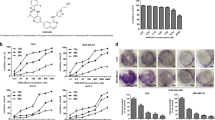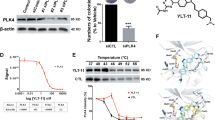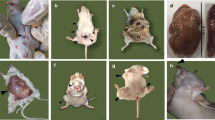Summary
The goals of the present study were to define the anticancer activity of LFM-A13 (α-cyano-β-hydroxy-β-methyl-N-(2,5-dibromophenyl)-propenamide), a potent inhibitor of Polo-like kinase (PLK), in a mouse mammary cancer model induced by 7,12-dimethylbenz(a)anthracene (DMBA) in vivo and explore its anticancer mechanism(s). We also examined whether the inhibition of PLK by LFM-A13 would improve the efficiency of paclitaxel in breast cancer growth in vivo. To do this, female BALB/c mice received 1 mg of DMBA once a week for 6 weeks with oral gavage. LFM-A13 (50 mg/kg body weight) was administered intraperitoneally with DMBA administration and continued for 25 weeks. We found that LFM-A13, paclitaxel, and their combination have a significant effect on the DMBA-induced breast tumor incidence, mean tumor numbers, average tumor weight, and size. At the molecular level, the administration of LFM-A13 hindered mammary gland carcinoma development by regulating the expression of PLK1, cell cycle-regulating proteins cyclin D1, cyclin dependent kinase-4 (CDK-4), and the CDK inhibitor, p21. Moreover, LFM-A13 treatment upregulated the levels of IκB, the pro-apoptotic proteins Bax, and caspase-3, and down-regulated p53 and the antiapoptotic protein Bcl-2 in mammary tumors. The combination of LFM-A13 with paclitaxel was found to be more effective compared with either agent alone. Collectively, these results suggest that LFM-A13 has an anti-proliferative activity against breast cancer in vivo and that LFM-A13 and paclitaxel combination could be a strategy for the treatment of breast cancer.




Similar content being viewed by others
References
Siegel RL, Miller KD, Jemal A (2017) Cancer statistics, 2017. CA Cancer J Clin 67(1):7–30. https://doi.org/10.3322/caac.21387
Shulman LN, Willett W, Sievers A, Knaul FM (2010) Breast cancer in developing countries: opportunities for improved survival. J Oncol 2010:595167. https://doi.org/10.1155/2010/595167
Vanderpuye V, Grover S, Hammad N, PoojaPrabhakar SH, Olopade F, Stefan DC (2017) An update on the management of breast cancer in Africa. Infect Agent Cancer 12:13. https://doi.org/10.1186/s13027-017-0124-y
Kumaraguruparan R, Seshagiri PB, Hara Y, Nagini S (2007) Chemoprevention of rat mammary carcinogenesis by black tea polyphenols: modulation of xenobiotic-metabolizing enzymes, oxidative stress, cell proliferation, apoptosis, and angiogenesis. Mol Carcinog 46(9):797–806. https://doi.org/10.1002/mc.20309
Donaldson MM, Tavares AA, Hagan IM, Nigg EA, Glover DM (2001) The mitotic roles of polo-like kinase. J Cell Sci 114(Pt 13):2357–2358
Archambault V, Glover DM (2009) Polo-like kinases: conservation and divergence in their functions and regulation. Nat Rev Mol Cell Biol 10(4):265–275. https://doi.org/10.1038/nrm2653
Lee SY, Jang C, Lee KA (2014) Polo-like kinases (plks), a key regulator of cell cycle and new potential target for cancer therapy. Dev Reprod 18(1):65–71. 10.12717/DR.2014.18.1.065
Liu X, Erikson RL (2003) Polo-like kinase (Plk)1 depletion induces apoptosis in cancer cells. Proc Natl Acad Sci U S A 100(10):5789–5794. https://doi.org/10.1073/pnas.1031523100
de Carcer G, Manning G, Malumbres M (2011) From Plk1 to Plk5: functional evolution of polo-like kinases. Cell Cycle 10(14):2255–2262. https://doi.org/10.4161/cc.10.14.16494
Toyoshima-Morimoto F, Taniguchi E, Nishida E (2002) Plk1 promotes nuclear translocation of human Cdc25C during prophase. EMBO Rep 3(4):341–348. https://doi.org/10.1093/embo-reports/kvf069
Takai N, Hamanaka R, Yoshimatsu J, Miyakawa I (2005) Polo-like kinases (Plks) and cancer. Oncogene 24(2):287–291. https://doi.org/10.1038/sj.onc.1208272
Conn CW, Hennigan RF, Dai W, Sanchez Y, Stambrook PJ (2000) Incomplete cytokinesis and induction of apoptosis by overexpression of the mammalian polo-like kinase, Plk3. Cancer Res 60(24):6826–6831
Wang Q, Xie S, Chen J, Fukasawa K, Naik U, Traganos F, Darzynkiewicz Z, Jhanwar-Uniyal M, Dai W (2002) Cell cycle arrest and apoptosis induced by human polo-like kinase 3 is mediated through perturbation of microtubule integrity. Mol Cell Biol 22(10):3450–3459
Li B, Ouyang B, Pan H, Reissmann PT, Slamon DJ, Arceci R, Lu L, Dai W (1996) Prk, a cytokine-inducible human protein serine/threonine kinase whose expression appears to be down-regulated in lung carcinomas. J Biol Chem 271(32):19402–19408
Dai W, Li Y, Ouyang B, Pan H, Reissmann P, Li J, Wiest J, Stambrook P, Gluckman JL, Noffsinger A, Bejarano P (2000) PRK, a cell cycle gene localized to 8p21, is downregulated in head and neck cancer. Genes Chromosom Cancer 27(3):332–336
Dai W, Liu T, Wang Q, Rao CV, Reddy BS (2002) Down-regulation of PLK3 gene expression by types and amount of dietary fat in rat colon tumors. Int J Oncol 20(1):121–126
Uckun FM, Dibirdik I, Qazi S, Vassilev A, Ma H, Mao C, Benyumov A, Emami KH (2007) Anti-breast cancer activity of LFM-A13, a potent inhibitor of polo-like kinase (PLK). Bioorg Med Chem 15(2):800–814. https://doi.org/10.1016/j.bmc.2006.10.050
Uckun FM (2007) Chemosensitizing anti-cancer activity of LFM-A13, a leflunomide metabolite analog targeting polo-like kinases. Cell Cycle 6(24):3021–3026. https://doi.org/10.4161/cc.6.24.5096
Rudolph D, Steegmaier M, Hoffmann M, Grauert M, Baum A, Quant J, Haslinger C, Garin-Chesa P, Adolf GR (2009) BI 6727, a polo-like kinase inhibitor with improved pharmacokinetic profile and broad antitumor activity. Clin Cancer Res 15(9):3094–3102. https://doi.org/10.1158/1078-0432.CCR-08-2445
Mahajan S, Ghosh S, Sudbeck EA, Zheng Y, Downs S, Hupke M, Uckun FM (1999) Rational design and synthesis of a novel anti-leukemic agent targeting Bruton's tyrosine kinase (BTK), LFM-A13 [alpha-cyano-beta-hydroxy-beta-methyl-N-(2, 5-dibromophenyl)propenamide]. J Biol Chem 274(14):9587–9599
Uckun FM, Zheng Y, Cetkovic-Cvrlje M, Vassilev A, Lisowski E, Waurzyniak B, Chen H, Carpenter R, Chen CL (2002) In vivo pharmacokinetic features, toxicity profile, and chemosensitizing activity of alpha-cyano-beta-hydroxy-beta- methyl-N-(2,5-dibromophenyl)propenamide (LFM-A13), a novel antileukemic agent targeting Bruton's tyrosine kinase. Clin Cancer Res 8(5):1224–1233
Fukui M, Yamabe N, Zhu BT (2010) Resveratrol attenuates the anticancer efficacy of paclitaxel in human breast cancer cells in vitro and in vivo. Eur J Cancer 46(10):1882–1891. https://doi.org/10.1016/j.ejca.2010.02.004
Hua F, Li K, JJ Y, Lv XX, Yan J, Zhang XW, Sun W, Lin H, Shang S, Wang F, Cui B, Mu R, Huang B, Jiang JD, ZW H (2015) TRB3 links insulin/IGF to tumour promotion by interacting with p62 and impeding autophagic/proteasomal degradations. Nat Commun 6:7951. https://doi.org/10.1038/ncomms8951
Sahin K, Tuzcu M, Sahin N, Akdemir F, Ozercan I, Bayraktar S, Kucuk O (2011) Inhibitory effects of combination of lycopene and genistein on 7,12- dimethyl benz(a)anthracene-induced breast cancer in rats. Nutr Cancer 63(8):1279–1286. https://doi.org/10.1080/01635581.2011.606955
Tuzcu M, Aslan A, Tuzcu Z, Yabas M, Bahcecioglu IH, Ozercan IH, Kucuk O, Sahin K (2012) Tomato powder impedes the development of azoxymethane-induced colorectal cancer in rats through suppression of COX-2 expression via NF-kappaB and regulating Nrf2/HO-1 pathway. Mol Nutr Food Res 56(9):1477–1481. https://doi.org/10.1002/mnfr.201200130
Liu Z, Sun Q, Wang X (2016) PLK1, a potential target for cancer therapy. Transl Oncol 10(1):22–32. https://doi.org/10.1016/j.tranon.2016.10.003
Wolf G, Hildenbrand R, Schwar C, Grobholz R, Kaufmann M, Stutte HJ, Strebhardt K, Bleyl U (2000) Polo-like kinase: a novel marker of proliferation: correlation with estrogen-receptor expression in human breast cancer. Pathol Res Pract 196(11):753–759. https://doi.org/10.1016/S0344-0338(00)80107-7
Weichert W, Kristiansen G, Winzer KJ, Schmidt M, Gekeler V, Noske A, Muller BM, Niesporek S, Dietel M, Denkert C (2005) Polo-like kinase isoforms in breast cancer: expression patterns and prognostic implications. Virchows Arch 446(4):442–450. https://doi.org/10.1007/s00428-005-1212-8
King SI, Purdie CA, Bray SE, Quinlan PR, Jordan LB, Thompson AM, Meek DW (2012) Immunohistochemical detection of polo-like kinase-1 (PLK1) in primary breast cancer is associated with TP53 mutation and poor clinical outcom. Breast Cancer Res 14(2):R40. https://doi.org/10.1186/bcr3136
Donizy P, Halon A, Surowiak P, Kaczorowski M, Kozyra C, Matkowski R (2016) Augmented expression of polo-like kinase 1 is a strong predictor of shorter cancer-specific overall survival in early stage breast cancer at 15-year follow-up. Oncol Lett 12(3):1667–1674. https://doi.org/10.3892/ol.2016.4890
Musgrove EA, Caldon CE, Barraclough J, Stone A, Sutherland RL (2011) Cyclin D as a therapeutic target in cancer. Nat Rev Cancer 11(8):558–572. https://doi.org/10.1038/nrc3090
Gartel AL, Tyner AL (2002) The role of the cyclin-dependent kinase inhibitor p21 in apoptosis. Mol Cancer Ther 1(8):639–649
Abbas T, Dutta A (2009) p21 in cancer: intricate networks and multiple activities. Nat Rev Cancer 9(6):400–414. https://doi.org/10.1038/nrc2657
Gilmore TD (2006) Introduction to NF-kappaB: players, pathways, perspectives. Oncogene 25(51):6680–6684. https://doi.org/10.1038/sj.onc.1209954
Degenhardt Y, Lampkin T (2010) Targeting polo-like kinase in cancer therapy. Clin Cancer Res 16(2):384–389. https://doi.org/10.1158/1078-0432.CCR-09-1380
Rushworth SA, Bowles KM, Barrera LN, Murray MY, Zaitseva L, MacEwan DJ (2013) BTK inhibitor ibrutinib is cytotoxic to myeloma and potently enhances bortezomib and lenalidomide activities through NF-kappaB. Cell Signal 25(1):106–112. https://doi.org/10.1016/j.cellsig.2012.09.008
Prashanth Kumar BN, Rajput S, Bharti R, Parida S, Mandal M (2015) BI2536--a PLK inhibitor augments paclitaxel efficacy in suppressing tamoxifen induced senescence and resistance in breast cancer cells. Biomed Pharmacother 74:124–132. https://doi.org/10.1016/j.biopha.2015.07.005
Acknowledgements
The authors thank Prof. Fatih Uckun (USC-USA) for kindly providing LFM-A13, and Prof. Gerard F. Hoyne (The University of Notre Dame Australia) for carefully reading and correcting grammar of the manuscript. The work was supported in part by the Turkish Academy of Sciences.
Funding
The work was supported in part by the Turkish Academy of Sciences.
Author information
Authors and Affiliations
Corresponding author
Ethics declarations
Conflicts of interest
All authors declare that they have no conflict of interest.
Ethical approval
All procedures performed in studies involving animals were in accordance with the ethical standards of the institution or practice at which the studies were conducted.
Informed consent
For this type of study, formal consent is not required.
Electronic supplementary material
ESM 1
(PDF 85 kb)
Rights and permissions
About this article
Cite this article
Sahin, K., Tuzcu, M., Yabas, M. et al. LFM-A13, a potent inhibitor of polo-like kinase, inhibits breast carcinogenesis by suppressing proliferation activity and inducing apoptosis in breast tumors of mice. Invest New Drugs 36, 388–395 (2018). https://doi.org/10.1007/s10637-017-0540-2
Received:
Accepted:
Published:
Issue Date:
DOI: https://doi.org/10.1007/s10637-017-0540-2




